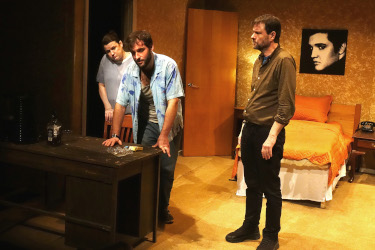
|
Beate Hein Bennett
March 6 – 23, 2025
What does an aspiring playwright living in New York City on subsistence between restaurant jobs and hope do when his mother makes an emergency call to come and pick up his parents and their car from the Hound Dog Motel, a per hour rental flee-bag on the outskirts of Memphis, Tennessee? He is to drive them back home to Staten Island! A nice son obliges and takes a twenty hour bus trip to…purgatory! He arrives to find his parents with bags packed ready to go but, as he is to find out quickly, his father is in some strange state of mind unable to drive. And from here on the family drama unravels in a brisk sketch of personal problems that touch on the social ills behind the American Dream, namely the dashed hopes and lack of opportunity experienced for decades among the working class. The play gives a capsule insight into the (somewhat) typical situation of young aspiring playwrights, directors, and actors in NYC: the hope “to make it” on the Big White Way, or to get a gig in TV, or the film industry with the ultimate hope (and enough money) to be able to give up lousy, exploitative jobs in restaurants, or as messengers, or proofreaders…and live fully as Artist. I suspect that Mr. Diriwachter has some experience with that quest, and that the title “Fog and Filthy Air” refers not only to the situation of the parents’ road trip but also metaphorically to life as an aspiring artist in NYC. The structure of the play is a brisk one-act in seventy minutes, resembling in style and substance a one-hour TV sit-com. Much of the dialogue, on the surface, deals with the problem of getting back from Memphis to New York before Tim has to appear for his waiting shift at the restaurant in Manhattan. His frustrating one-way brief telephone calls with colleagues who might switch shifts with him consume a fair amount of the text. However, Tim’s job problem becomes the trigger for uncovering deeper stresses and tensions in the triangular family relationships, especially between father and son, and revealing also a few crucial bits about the history of his parents’ marital life. Ultimately all gets resolved and the three embark on the road back home. If this play were part of a TV series, the next installment could be the car trip home with more revelatory banter among the three, and roadside observations about the state of America. The production is directed by Jonathan Weber who has collaborated with Mr. Diriwachter before on several of his plays. The set design by Evan Frank is a cheap motel room fashioned 80s style in shades of faded rose and red with twin beds, a bulky TV, a black rotary telephone on a bedside table, a bible in the drawer, a bulky telephone book, and on the wall a prominent portrait of Elvis Presley—we are in the vicinity of Graceland. A half-empty bottle of Bourbon whiskey on a desk downstage foreshadows an issue-to-come. In this symmetrical realistic set the three actors negotiate with each other. Steven Gamble plays Tim as a hyperactive young man with nerves on edge throughout. Bob Homeyer is Father, a “very tired” man who appears broken by life after having worked hard menial jobs and who feels that he never amounted to much except to put bread on the table, and to put his son through college. Kate A. McGrath plays Mother with sensitivity; she is a well-meaning straight-forward middle-aged housewife who tries to mediate between the two men, something she’s probably done all her married life—she was only seventeen when she got married and had Tim eleven months later. However, one can sense that she is also a bit fearful of (and for) her husband. Mr. Weber’s direction encourages subtle changes in tone within quick shifts in mood. These mood shifts indicate unarticulated psychological traumas and are literally highlighted by Alexander Bartenieff’s lighting design through sudden color tone changes. In all it is a pleasant well-done production, modest and entertaining.
|
| recordings | coupons | publications | classified |

